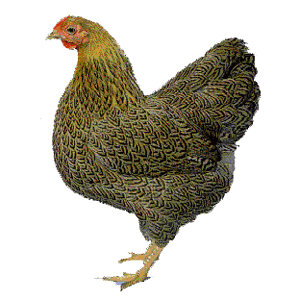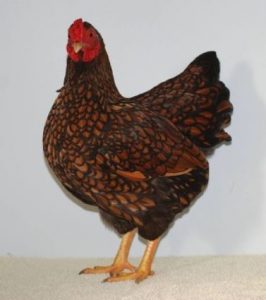
Overview
The Silver Laced Wyandotte is the parent variety of the Wyandotte family. It originated in New York State. It was first known as ‘American Sebright’ and ‘Sebright Cochin.’
The true origin is shrouded in mystery……. The Dark Brahma and Spangled Hamburgs were used by the originator of the ‘American Sebright’ was evidenced by the cropping out of the Hamburg comb and Dark Brahma color markings in some of the earlier Eastern strains. Classification is ‘heavy soft feather’.
Male 8.5 lbs (3.9kg) Female 6.5lbs (3kg)
Bantam Male 30oz (850g) Bantam Female 26oz (740g)
Eggs
Egg Color
Some lay light brown and others
Egg Size
Medium-Large
Egg production
180 per annum
The golden laced variety can lay up to 260 eggs per year.
When do they start laying eggs?
Around 18-25 weeks, they are a larger, heavier bird and as such can take slightly longer to lay eggs than other smaller breeds however they as a breed do mature fairly quickly.
Wyandotte Characteristics
Temperament / Are they good as pets?
Yes the Wyandotte chicken would make a great pet as they are so friendly. Also they are a very docile bird meaning they would be a very good fit for children. However on the odd occasion this breed can be aggressive…
How do I tame Wyandotte chickens?
If you have chicks start by handling them 3 times a day so they begin to get used to human interaction and build up trust with you. They will be easier to tame if you have them from chicks, but they are so friendly and docile anyway as a breed they are great to tame and will naturally show you affection.
How many do I need to buy?
I have introduced one hen to my flock of 10 chickens with no issues. Typically best bought in twos as then they have a best, however a great sized small flock is about 6 chickens.
How much space do they need?
They don’t require any more space than other breeds and can handle both confinement and being free range, however as a generally rule of thumb no less and this is absolute minimum of 11sqft per chicken (1.1m2).
Appearance
Wyandotte Chicken Breeds
Golden Laced Wyandottes ( as shown in the photo below) originated in Wisconsin. They were produced by mating Silver Laced Wyandotte females with a cross-bred Partridge Cochin-Brown Leghorn cockerel. The golden laced variety is very popular and has both males and females are distinguishable by their unique plumage and black tail.

The color pattern of the Sebright Bantam has been more or less of an ideal for breeders of Silver and Golden Laced Wyandottes. It is one that should conform to the larger size of the fowl by having more sharply defined and wider black lacing to harmonize with the broader oval center of the feather.
White Wyandottes came from sports of the Silver Laced in New York State. The feather is important in Wyandottes, especially in the White variety, where broad feathers and smooth plumage characteristic of the Wyandotte.
Buff Wyandottes were light colored Rhode Island Reds, but lacking type and off in color, they laid the foundation of Buff Wyandottes for breed, type and color. Golden and White Wyandotte crosses and Buff Cochin-White and Golden Wyandotte crosses dominated in some strains.
Black Wyandottes originated from black sports of the Silver Laced variety.
Partridge Wyandottes originated in the East and West US. The Partridge Cochin for the color patterns for both the Eastern and Western strains, but the varieties with which the Cochin were crossed differed. The Eastern strain was a Partridge Cochin-Golden Wyandotte cross; the Western strain Partridge Cochin-Cornish-Golden Wyandotte crosses.
Silver Penciled Wyandottes were produced blending two strains; one Partridge Wyandotte-Dark Brahma cross, the other, a cross of Silver Laced Wyandottes and Silver Penciled Hamburgs cross.
Columbian Wyandottes were named for the 1893 Columbian Exposition held in Chicago in 1893. This variety was produced by crossing a White Wyandotte and a Barred Plymouth Rock.
Feeding
What should I feed them?
Nothing special about keeping a Wyandotte chicken, feed them as you would any other breed. That’s chick crumb or mash up to 6 weeks old.
Move them onto growers mash after that, then at around the 18 weeks, begin to transfer onto layer pellets this will have all the right nutrients for them to lay gorgeous brown eggs for your breakfast table!
How much should I feed them?
Chickens, regardless of breed, eat between 2.9 oz (80g) and 4.2oz (120g) per day. The Wyandotte aren’t renown foragers so may well eat 4.2oz a day of feed from yourselves. They are moderately large birds remember. Grit is essential especially so a bag of grit should be near the top of the shopping list – it looks like this
What can’t they eat?
Please read – the two main offenders are chocolate and beans, dried beans being even worse than non dried. Feeding your chickens beans or chocolate can result in death usually through cardiac arrest, so you have to be very vigilant. Beans can usually sneak in if you feed chickens scraps, which is in fact illegal to do in the UK. Yes that’s right its illegal to feed chickens scraps in the United Kingdom!
Moldy food is another bad point, to leave the playing field if you wouldn’t eat it – hens shouldn’t its that simple. Remember they can go and tell anyone they are unwell and a lot of the time can suffer in silence so feed them anything that could cause harm- they will love you for it!
For all the information you need on feeding chickens – read this!
What do I need to keep chickens?
- A coop! These birds need a roosting high of 2-4ft, hens like to be naturally off the floor, its an inbuilt safety mechanism, id therefore look to purchase a coop like the following for Wyandottes.
- You need a feeder I always recommend, as a lot of people ask, a metal one. It will last longer, it wont get knocked over, there’s a lid on it saving it from the rain. This means less spoil, plus to its not in direct sunlight so wont make the feed go bad. On really important part is get one with a lid, sounds simple but chicks and chickens will jump in else, a poop.
- You need a waterer
Breed tips:
- Well suited bird for the extreme cold due to their short rose comb – so suggested if you live in an area that has quite harsh winters.
- Very docile and make good moms and dads!
